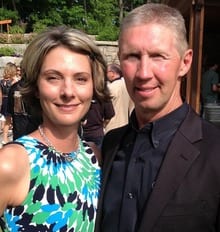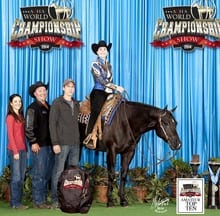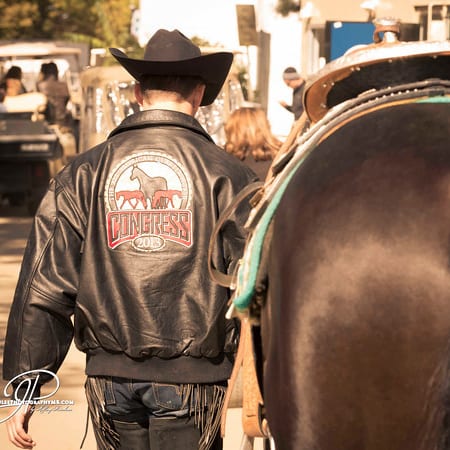Show horses change hands, handlers, or programs, all the time; it’s often the nature of what we do. In 2014, the best way to move to a new trainer was a hot topic. However, every discussion about this subject came from the person’s perspective. But did we forget about the horse? While moving a new horse into a trainer’s program can be hard on the humans, the horse has to make the change, too, which needs to be handled just as carefully.
GoHorseShow.com talked to some of today’s top trainers to find out, from the horse’s perspective, what advice they have to make the best transition. They all say that taking it slow and using thoughtfulness is the key, whether it’s a halter or performance horse. But fitting the horse into the appropriate program is just as much of a consideration in the overall satisfaction of the transition.
The Initial and Patient Steps
Getting a new horse situated in the unfamiliar facility comes first before anything else can happen, according to World and Congress Champion trainers, Ashley and Kenny Lakins of Lakins Quarter Horses in Wilmington, Ohio (pictured below).

“Usually when we buy a new horse, we try to let them get accustomed to our barn for a few days and we let the new babies also hang out before really training them a whole lot,” they explain.
Some of the integration also involves feeding and nutrition, emphasizes trainer Deanna Searles, part of the Multiple World and Congress Championship duo of Searles’ Circle S Ranch in Scottsdale, Arizona.
“Nutrition is often the first question I ask about a new horse, since you immediately need to start feeding right away. We feed pellets, so if a horse has been exclusively on hay, we add a little pellets with the hay, and eventually transition the horse to the pellets over time. Everything is done gradually.”
Trainer, Jason English of Jason English Show Horses in Madison, Georgia, agrees that any transition in feed should be gradual, but he reminds us that it’s important to think about this before the horse is ever moved. “No matter what the horses were fed before, they need to come with a supply of what they were eating at the previous place,” the World and Congress Champion trainer says.
For AQHA Multiple World and Congress Champion halter trainer Joe Engle of Blue Ribbon Ranch in Whitesboro, Texas, the health of the horse is assessed right away from head to toe before any training begins. “When I have a new show horse or prospect that comes into the show barn, I first pull blood to check overall health of the animal; second, I have my equine dentist do a full oral examination of the horse; third, I evaluate the horse’s feet and legs. No hoofs, no horse,” declares Engle.
Getting to Know the Horse

Before trainers start riding or training an unfamiliar horse, networking and inquiry pays off. All the trainers admit it’s a bit simpler for both horse and trainer if they know where the horse came, especially if the training was comparable. “It does make it easier if I know who had the horse before me, and if where they were previously also has similar training techniques. A lot of times those horses just fall right in to the new program,” says English (pictured left). “But if you don’t know who the trainer was before you, then you want to ask the owner what classes they did before and how did they prepared the horse before, and those types of questions. The way you transition them will vary depending on the horse and what program it has experienced.”
The Lakins agree wholeheartedly that it is important to ask both owner and trainer several questions even before making the purchase. “If the horse has done very well in their program, we would like to keep most of the horse’s program the same. We bought the horse and liked it enough to buy it, so, we try not to change too much. Any and all information, even if it’s good and some bad, is always appreciated.”
For them, the questions extend to the show day for later reference, including how the horse has been prepped, longed, and they stress asking about other support systems used. “Does the horse get banamine and bute, and we want to know if the horse has been treated for ulcers – it’s really important to know!” they reveal.
“I do like to know where the horse came from, but I also like to know who originally started the horse, because the horse will always come back to that original foundation, no matter what has happened in its training in between,” clarifies Searles, who has found this to be the case after many years in the business. “That knowledge helps us progress with the horse a great deal, especially if we know the original program was complimentary to ours.”
Transitioning the Training

Engle says (pictured left) that evaluating a horse carefully before moving forward into his program is a necessity. “I always try to assess the horse thoroughly before I start a training regime. All horses have holes or problem areas, and since I don’t train any of my horses the exact same way, this knowledge is important to move forward,” he explains.
Both English and Lakins say to expect the training itself to begin at a slow rate and the element of evaluation is a crucial part of the first steps. “You go slowly because you don’t want to jump in with both feet, as horses are all individuals,” says English. “Some progress at a faster rate, and some take longer. If somebody sends me a horse I didn’t choose, I’m going to ride this horse and evaluate, and figure out what I like and don’t like. I won’t work hard on what I do like about the horse’s training, but I’ll focus on adding in what I think is missing.”
“Training goes a little slower paced in the beginning,” the Lakins concur. “The first few rides we spend just trying to get to know the horse and get along and then we try to add a few new things after a few rides. You hope each day you ride a new horse they learn a little bit and can build and retain what you have taught them the day before. How different the program was before will determine how long it might take a horse to get accustomed to the new way of doing things.”
Searles approaches it the same way, and recommends that everyone should expect the transition to take time. “More than anything, we start out slowly and see what the horse knows. Some horses will come requiring a lot of leg, and others can be ridden with more hand. What we always do is assess the horse, decide what is fundamental to him or her, and then gradually add little pieces of our own training to finish the horse to our program. It does take a few months, and sometimes longer, to integrate the new horse into your barn.”
Backing up a Bit

Though an abundance of advice exists for buying that new horse, or knowing when it’s time to move on, the experts still advise to think before you leap into a new purchase or into your new barn. They suggest that the well-known practice of the trainer wanting some input on the purchase of a horse, or the acceptance of a new horse, has a great deal of merit. Even with the process of easing a horse into a new training regimen, it may not work if all parties were not involved in the decision.
“It’s really important to involve your trainer in your purchase of a new horse,” states Searles (pictured left). “Often we will watch a horse and absolutely love how it goes and would never want to change it. But, if we go to look at the horse and ride it to consider purchase, sometimes we realize it may not fit into our program, and since we love how it already performs, we would not want to change that to suit ourselves and lose the magic that horse has. So whether you want to move a horse into a new program at all is often the biggest decision, so backing up and considering those factors is crucial for the happiness of both horse and owner. While many of us have the same basics, we all have our own unique ways of fine-tuning our horses that we have developed over time, and you really want to make sure the purchase and transition make sense. Above all, being honest whether a horse fits into your program, is best for everyone in the long run, especially the horse.”
English explains that he’s lucky to have a relationship with his clients that allows an initial evaluation to take place with everyone working together, but it doesn’t always happen with a new client bringing in an unfamiliar horse. “The biggest thing to remember is for everyone to be open and honest about how a horse is fitting into a program. If it’s a horse the trainer can get along with and build a great relationship with, everyone can have a lot of fun together.”
About the author: Delores Kuhlwein, a freelance equine writer, shows and breeds American Paint Horses and American Quarter Horses together with her husband, Mark, in Glendale, Arizona. Delores began sharing her lifetime love of horses through writing in 2011 after retiring from 15 years as an educator. In addition to being active with her local regional Paint Horse club and the American Paint Horse Association, she manages two family-owned businesses. Her favorite activities are showing her beloved mare in amateur events, and traveling with her husband and two dogs.
 “Usually when we buy a new horse, we try to let them get accustomed to our barn for a few days and we let the new babies also hang out before really training them a whole lot,” they explain.
“Usually when we buy a new horse, we try to let them get accustomed to our barn for a few days and we let the new babies also hang out before really training them a whole lot,” they explain.
 Before trainers start riding or training an unfamiliar horse, networking and inquiry pays off. All the trainers admit it’s a bit simpler for both horse and trainer if they know where the horse came, especially if the training was comparable. “It does make it easier if I know who had the horse before me, and if where they were previously also has similar training techniques. A lot of times those horses just fall right in to the new program,” says English (pictured left). “But if you don’t know who the trainer was before you, then you want to ask the owner what classes they did before and how did they prepared the horse before, and those types of questions. The way you transition them will vary depending on the horse and what program it has experienced.”
Before trainers start riding or training an unfamiliar horse, networking and inquiry pays off. All the trainers admit it’s a bit simpler for both horse and trainer if they know where the horse came, especially if the training was comparable. “It does make it easier if I know who had the horse before me, and if where they were previously also has similar training techniques. A lot of times those horses just fall right in to the new program,” says English (pictured left). “But if you don’t know who the trainer was before you, then you want to ask the owner what classes they did before and how did they prepared the horse before, and those types of questions. The way you transition them will vary depending on the horse and what program it has experienced.”
 Engle says (pictured left) that evaluating a horse carefully before moving forward into his program is a necessity. “I always try to assess the horse thoroughly before I start a training regime. All horses have holes or problem areas, and since I don’t train any of my horses the exact same way, this knowledge is important to move forward,” he explains.
Engle says (pictured left) that evaluating a horse carefully before moving forward into his program is a necessity. “I always try to assess the horse thoroughly before I start a training regime. All horses have holes or problem areas, and since I don’t train any of my horses the exact same way, this knowledge is important to move forward,” he explains.
 Though an abundance of advice exists for buying that new horse, or knowing when it’s time to move on, the experts still advise to think before you leap into a new purchase or into your new barn. They suggest that the well-known practice of the trainer wanting some input on the purchase of a horse, or the acceptance of a new horse, has a great deal of merit. Even with the process of easing a horse into a new training regimen, it may not work if all parties were not involved in the decision.
Though an abundance of advice exists for buying that new horse, or knowing when it’s time to move on, the experts still advise to think before you leap into a new purchase or into your new barn. They suggest that the well-known practice of the trainer wanting some input on the purchase of a horse, or the acceptance of a new horse, has a great deal of merit. Even with the process of easing a horse into a new training regimen, it may not work if all parties were not involved in the decision.






